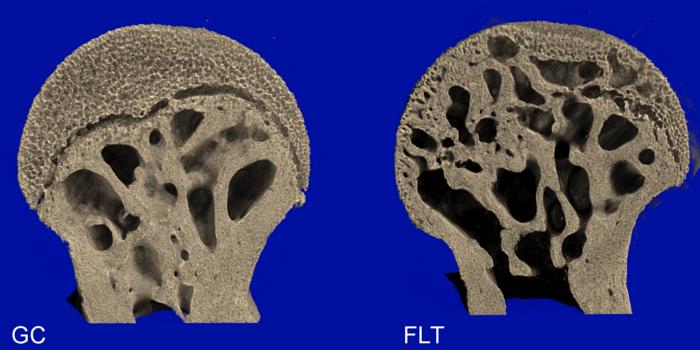In an unprecedented study published in PLOS One, researchers have unraveled the significant effects of microgravity on the skeletal system of female C57BL/6J mice. The investigation explored the ramifications of a 37-day exposure to microgravity, mimicking the conditions of spaceflight, and revealed a substantial correlation between this exposure and bone loss at weight-bearing skeletal sites. As space exploration continues to push boundaries, understanding the biological consequences of microgravity becomes more crucial than ever.
The research team, supported by NASA Space Biology Grant NNH14ZTT001N14-14SF, set out with a keen focus on the femoral head bone and cartilage. By utilizing MicroCT imaging techniques, the researchers meticulously analyzed the changes occurring in these critical areas. Their findings clearly illustrated a phenomenon known as premature secondary ossification, where the normal maturation process of bone and cartilage is disrupted due to the weightless environment.
One of the primary concerns in space biology centers around the implications of prolonged microgravity on the human body. Astronauts are known to face a myriad of health challenges, particularly with bone density. The structural integrity of bones is paramount for astronauts, as weaker bones could lead to fractures and other complications during and after missions. This study offers essential insights that may help mitigate health risks for future space travelers.
Furthermore, the study draws attention to the specific impact of microgravity on sites that are generally subjected to mechanical loading on Earth. Weight-bearing bones, such as those in the lower limbs, appear particularly vulnerable to the degenerative effects of microgravity. This raises pertinent questions about the adaptive mechanisms that allow bones to respond optimally to mechanical stress—or the lack thereof—in space.
The researchers underscored the importance of such studies in light of upcoming missions that aim to send humans to Mars. The data gathered could be instrumental in developing countermeasures to preserve bone health for individuals who will be exposed to microgravity for extended periods. Potential strategies could include targeted exercise regimens or nutritional interventions formulated to enhance bone density.
In addition to the mechanical loading aspect, the research highlights the role of biological pathways involved in bone metabolism. The study suggests that changes in cellular signaling during microgravity exposure may contribute to the observed bone loss. This discovery opens new avenues for further investigation into how microgravity influences metabolic processes, which could have wider implications beyond just skeletal health.
The interaction between microgravity and various physiological systems is complex, compelling researchers to broaden their focus. Future investigations are likely to examine how microgravity affects muscle integrity and cardiovascular function alongside skeletal health. Understanding these interconnected systems will be crucial for developing holistic approaches to maintaining astronaut health during long-duration space missions.
Moreover, such findings could have meaningful ramifications for populations on Earth facing conditions associated with bone loss, such as osteoporosis or extended bed rest. The mechanisms elucidated in this study may provide insights into preventative strategies or therapeutic approaches that address similar challenges in these groups.
As the community of scientists continues to unravel the mysteries of human health in space, it becomes increasingly evident that multi-disciplinary collaboration will be key. Scientists specializing in materials, biology, and engineering must come together to create innovative solutions that safeguard astronaut health. The urgency of this collaborative approach is amplified by NASA’s long-term vision, which includes extended missions beyond low Earth orbit.
The overarching message from this study is clear: as humanity gears up for a more profound exploration of our solar system, understanding the biological ramifications of living in space is paramount. With developments on the horizon, such as lunar bases and Mars colonies, ensuring the health and well-being of astronauts will be essential in our quest to explore new frontiers.
Education and training will also play crucial roles in preparing astronauts for the challenges that lie ahead. Engaging potential crew members in understanding their body’s responses to spaceflight can empower them to make informed decisions about health and wellness during missions. This proactive approach could potentially mitigate the risks associated with bone loss and other health concerns in microgravity.
In conclusion, the exploration of microgravity’s impact on bone health serves as a pivotal reminder of the importance of integrating biological research with space exploration endeavors. The findings of this study not only illuminate the challenges faced by astronauts but also underscore the potential for innovative solutions that could redefine our approach to human health in space. As we embark on this new era of exploration, ensuring astronaut health remains a foremost priority.
Subject of Research: Impact of microgravity on bone health in female C57BL/6J mice
Article Title: 37-Day microgravity exposure in 16-Week female C57BL/6J mice is associated with bone loss specific to weight-bearing skeletal sites
News Publication Date: 26-Mar-2025
Web References: PLOS One
References: N/A
Image Credits: Eduardo Almeida, Rukmani Cahill, and Elizabeth Blaber, CC-BY 4.0
Keywords
Microgravity, bone health, astronauts, skeletal system, space biology, osteoporosis, C57BL/6J mice, premature ossification, NASA, research study.
Tags: astronaut health challenges in spacebone density reduction in astronautsbone loss in spaceC57BL/6J mice studyimplications for human spaceflightMicroCT imaging in researchmicrogravity effects on bone healthNASA space biology researchpremature secondary ossificationskeletal system in microgravityspace exploration and biological consequencesweight-bearing skeletal sites





